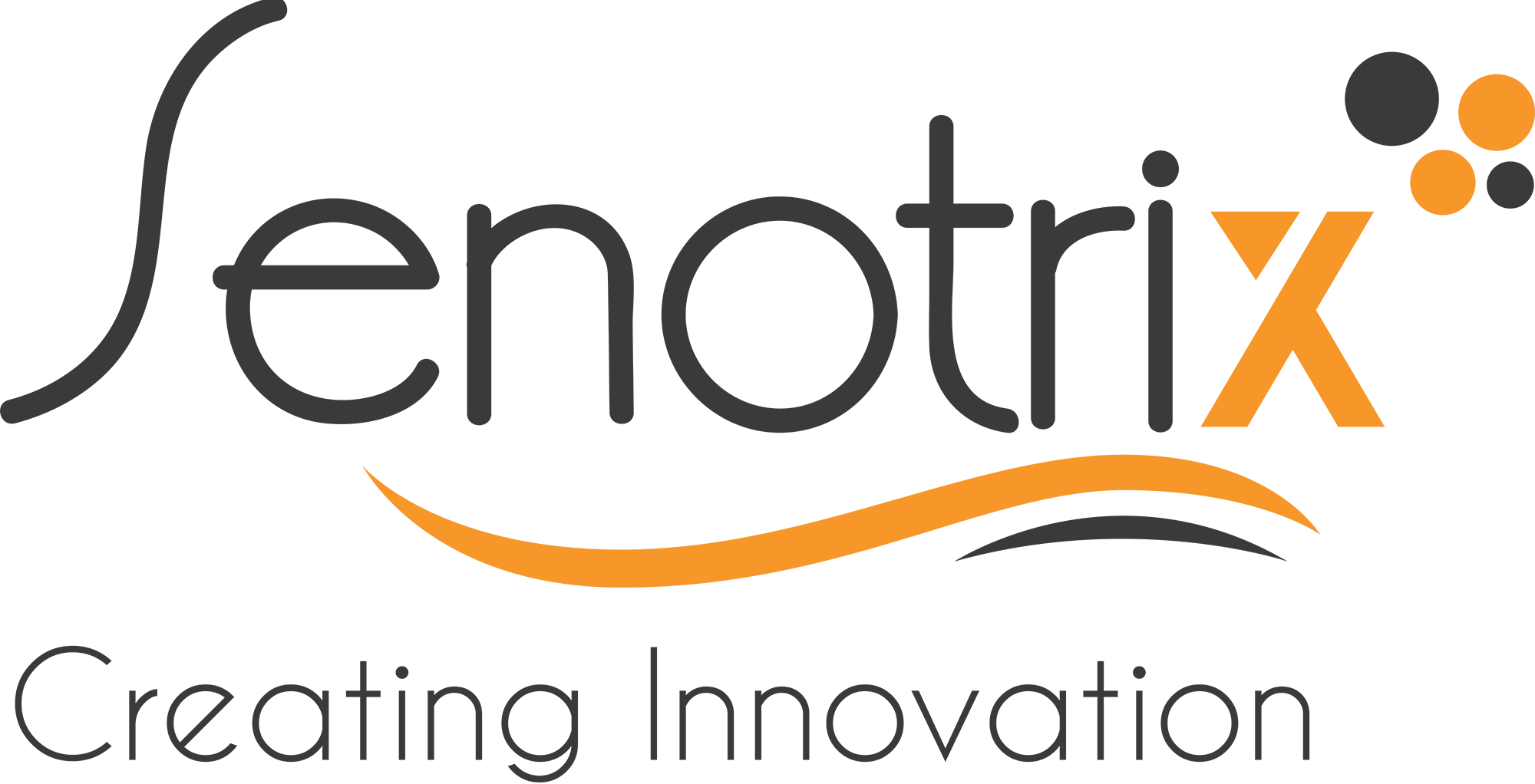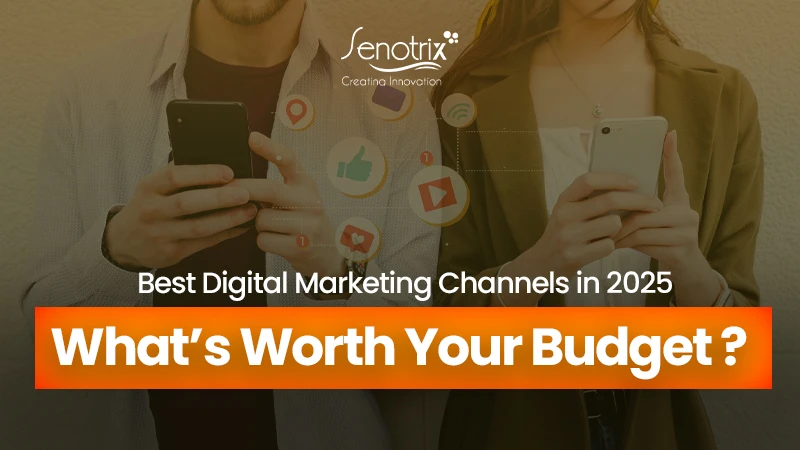[TL;DR]
In 2025, the most profitable digital marketing channels are SEO, email marketing, influencer campaigns, and strategic paid ads. Businesses wasting budget on low-ROI platforms fall behind. Focus your efforts on channels that align with your goals, audience behaviour, and long-term growth. Senotrix helps UK businesses identify and optimise the right mix of digital channels to drive higher revenue with less waste.
___________________________________________________________________
Your marketing budget is vanishing into channels that don’t deliver results. Every pound spent on ineffective platforms is money that could drive real growth. Most businesses scatter their marketing efforts across dozens of channels, hoping something will stick. They invest in flashy new platforms while ignoring proven strategies that actually generate revenue. This spray-and-pray approach wastes resources and delivers disappointing results.
60% of marketing budgets are wasted on ineffective channels. Companies that focus on high-ROI channels see 5x better results than those spreading resources thin across everything.
The digital marketing landscape has evolved dramatically in 2025. New channels emerge monthly while traditional platforms change their algorithms. Success requires strategic channel selection based on ROI, audience behaviour, and business goals rather than following trends. Selecting the right marketing channels maximises ROI while minimising wasted spend. Your business type, target audience, and available budget determine which channels will deliver the best results for your specific situation.
Every business deserves marketing that drives real returns. Senotrix, being the leading digital marketing agency UK, helps you start targeting channels that boost revenue. Let us show you what’s working and what’s draining your budget.
[Claim Your Free Digital Marketing Audit]
Top Digital Marketing Channels to Invest in 2025
Smart marketers focus their budgets on channels that consistently deliver measurable results. The highest-performing channels combine strong ROI with sustainable growth potential and audience reach.
Every marketing channel requires different levels of investment, time commitment, and expertise. Understanding these differences helps you allocate resources effectively and set realistic expectations for results.
The channels listed below represent the highest-performing options based on current ROI data, audience engagement rates, and long-term growth potential. Each offers unique advantages depending on your business type, target market, and available resources.
| Channel | Average ROI | Time to Results | Initial Investment | Best For |
| SEO | 700%+ | 3-6 months | Medium | Long-term growth |
| Email Marketing | 260% | 1-2 months | Low | Lead nurturing |
| Influencer Marketing | 200-700% | 1-3 months | Medium-High | B2C brands |
| Social Media | 150-400% | 2-4 months | Low-Medium | Brand awareness |
| Paid Search | 100-200% | Immediate | Medium-High | Quick traffic |
| Video Marketing | 200-500% | 2-3 months | Medium | Engagement |
Search Engine Optimisation (SEO)
SEO consistently delivers the highest ROI among all digital marketing channels. Most businesses see returns exceeding 700% from well-executed SEO strategies, making it the most cost-effective long-term investment.
Why SEO leads in ROI:
- Compound returns: Rankings improve over time, creating exponential growth
- Owned traffic: You control your content and don’t pay for each visitor
- Trust building: High rankings establish credibility and authority
- 24/7 performance: Content works around the clock without ongoing costs
- Qualification advantage: Search users have high purchase intent
SEO requires patience but delivers lasting results. Most businesses see significant improvements within 3-6 months, with full potential realised after 12-18 months of consistent effort.
Key SEO tactics that deliver value:
- Technical optimisation: Site speed, mobile responsiveness, crawl efficiency
- Content strategy: Targeting high-intent keywords with valuable information
- Link building: Earning backlinks from authoritative industry websites
- Local SEO: Optimising for location-based searches and Google Business profiles
- User experience: Improving site navigation and reducing bounce rates
Pro Tip:
Focus on long-tail keywords with commercial intent rather than high-volume generic terms. These convert better and face less competition.
Email Marketing
Email marketing delivers exceptional ROI while giving you complete ownership of your audience data. This channel averages 260% ROI and remains one of the most effective ways to nurture leads and retain customers.
Email marketing advantages:
- Direct communication: Reach customers without algorithm interference
- Personalisation capability: Tailor messages based on behaviour and preferences
- Automation potential: Set up sequences that work automatically
- Measurable results: Track opens, clicks, and conversions precisely
- Cost efficiency: Low per-contact costs compared to other channels
Best practices for email success:
- Segmentation: Group subscribers by behaviour, interests, and purchase history
- Personalisation: Use names, past purchases, and browsing behaviour
- Mobile optimisation: Ensure emails display correctly on all devices
- A/B testing: Test subject lines, send times, and content formats
- Value focus: Provide useful content rather than constant promotions
Data-Driven Results:
Segmented email campaigns generate 760% higher revenue than non-segmented campaigns. Personalisation increases engagement by 200% on average.
Influencer Marketing
Influencer marketing delivers high ROI, especially for B2C brands and select B2B markets. Brands typically see returns between 200% and 700% when partnering with relevant influencers and tracking performance carefully.
Influencer marketing effectiveness factors:
- Audience alignment: Choose influencers whose followers match your target market
- Engagement rates: Prioritise engagement over follower count
- Authenticity: Work with influencers who genuinely use your products
- Content quality: Ensure professional, brand-aligned content creation
- Performance tracking: Monitor clicks, conversions, and sales attribution
Choosing the right influencers:
- Micro-influencers: 10K-100K followers often deliver better ROI than mega-influencers
- Niche relevance: Industry-specific influencers reach qualified audiences
- Engagement analysis: Review comment quality and audience interaction
- Content style: Ensure their aesthetic matches your brand image
- Previous partnerships: Analyse results from their past collaborations
Combining organic and paid elements:
- Organic partnerships: Long-term relationships with brand ambassadors
- Paid promotions: Sponsored posts for specific campaigns and launches
- User-generated content: Encouraging followers to create brand content
- Cross-platform presence: Leveraging influencer content across multiple channels
Want to identify the perfect marketing channels for your business? Senotrix’s digital marketing agency UK experts analyse your audience and competition to recommend the highest-ROI channels.
Social Media Marketing and Advertising
Social media combines organic relationship building with paid advertising opportunities. Instagram, Facebook, TikTok, and YouTube deliver the highest ROI when used strategically for audience engagement and conversion.
Platforms with the highest ROI:
- Instagram: Visual content and shopping features drive conversions
- Facebook: Detailed targeting options and diverse ad formats
- TikTok: Viral potential and younger audience engagement
- YouTube: Long-form content and educational video opportunities
- LinkedIn: B2B networking and professional content sharing
Organic vs. paid social strategies:
- Organic focus: Building community, sharing valuable content, and customer service
- Paid advantages: Precise targeting, immediate reach, guaranteed visibility
- Hybrid approach: Using organic content to inform paid campaign strategies
- Content repurposing: Maximising value from each piece of content created
Leveraging engaging formats:
- Stories: Behind-the-scenes content and time-sensitive promotions
- Reels: Short-form video content for maximum reach and engagement
- Live streaming: Real-time interaction and product demonstrations
- User-generated content: Customer testimonials and authentic experiences
Paid Search Marketing (SEM/PPC)
Paid search delivers immediate traffic and works well for product launches despite lower ROI than organic channels. Success depends on careful budget management and precise targeting to maximise efficiency.
When to use paid search:
- New product launches: Immediate visibility for unknown products
- Seasonal campaigns: Capitalising on time-sensitive opportunities
- Competitive keywords: Competing for high-value search terms
- Geographic targeting: Reaching specific local markets quickly
- Testing opportunities: Validating demand before investing in SEO
Budget and targeting optimisation:
- Keyword research: Focus on high-intent, commercial keywords
- Negative keywords: Exclude irrelevant searches to reduce wasted spend
- Ad scheduling: Run ads when your audience is most active
- Geographic targeting: Limit spending to profitable locations
- Device optimisation: Adjust bids based on device performance
Content Marketing Insight:
Companies combining SEO and PPC see 25% higher click-through rates and 27% higher profits than using either channel alone.
Video Marketing
Video content drives higher engagement and conversion rates across all platforms. YouTube, TikTok, and Instagram Stories provide the biggest opportunities for video marketing success in 2025.
Video marketing benefits:
- Engagement boost: Video content receives 1200% more shares than text and images
- SEO improvement: Videos increase time on page and reduce bounce rates
- Conversion increase: Landing pages with video see 80% higher conversions
- Mobile optimisation: Video performs exceptionally well on mobile devices
- Versatility: One video can be repurposed across multiple platforms
Popular platforms and formats:
- YouTube: Long-form educational content and product demonstrations
- TikTok: Short-form entertainment and trending content
- Instagram Stories: Behind-the-scenes content and product showcases
- Facebook Video: Social sharing and community building
- LinkedIn Video: Professional content and thought leadership
Using AI tools to scale video creation:
- Script generation: AI tools help create video scripts and content ideas
- Automated editing: Software streamlines video production workflows
- Thumbnail creation: AI generates eye-catching video thumbnails
- Subtitle generation: Automatic transcription improves accessibility
- Performance optimisation: AI analyses video performance and suggests improvements
Emerging Channel: Organic LLM Traffic
AI-driven traffic from language models and answer boxes represents a rapidly growing opportunity. Early adopters report 40% higher qualified leads and 60% lower content acquisition costs compared to traditional search.
What is Organic LLM Traffic?
- Language model responses: AI tools citing your content in their answers
- Answer box optimisation: Appearing in featured snippets and knowledge panels
- Voice search results: Optimisation for voice-activated queries
- AI-powered recommendations: Content suggested by AI assistants
- Conversational search: Natural language query optimisation
Early performance stats:
- 40% higher lead quality: AI-referred traffic shows stronger purchase intent
- 60% lower acquisition costs: Organic AI traffic requires less ongoing investment
- 200% longer engagement: Users spend more time with AI-recommended content
- 15% higher conversion rates: AI-qualified traffic converts more effectively
How to optimise for LLM visibility:
- Structured data: Use schema markup to help AI understand your content
- Direct answers: Create content that directly answers specific questions
- Authority building: Establish expertise through comprehensive, factual content
- Citation optimisation: Make your content easy for AI to reference and cite
- Natural language: Write in conversational, question-answering formats
Change your content strategy for AI-driven search results. Our SEO specialists understand how to optimise for both traditional search and emerging AI channels.
[Get Your LLM Optimisation Strategy]
How to Choose the Right Channels for Your Business
Channel selection depends on your business goals, target audience, and available resources. The right combination varies significantly between B2B and B2C businesses, industries, and budget levels. Many businesses make the mistake of copying competitors’ channel strategies without considering their unique circumstances. What works for a large e-commerce company might not work for a local service business. Success requires matching channels to your specific situation.
Data-Driven Results:
Companies that align their channel selection with business objectives see 67% better ROI than those using generic approaches. Strategic channel selection prevents wasted spending and accelerates growth.
Your channel mix should evolve as your business grows and market conditions change. Start with channels that match your current capabilities and gradually expand as you build expertise and resources.
| Business Type | Primary Channels | Supporting Channels | Budget Allocation |
| B2B Services | SEO, Email, LinkedIn | Content, PPC | 40% SEO, 30% Email, 20% Content, 10% PPC |
| E-commerce | SEO, PPC, Email | Social Media, Video | 30% SEO, 25% PPC, 25% Email, 20% Social |
| Local Business | Local SEO, Google Ads | Social Media, Email | 50% Local SEO, 30% Google Ads, 20% Social |
| SaaS | Content, SEO, Email | PPC, Social Media | 35% Content, 30% SEO, 25% Email, 10% PPC |
Aligning Channel Selection with Business Goals
Different marketing channels serve different business objectives. Align your channel choice with specific, measurable goals rather than trying to be everywhere at once.
Goal-based channel selection:
- Brand awareness: Social media, influencer marketing, video content
- Lead generation: SEO, content marketing, email campaigns
- Sales conversion: PPC, retargeting, email automation
- Customer retention: Email marketing, social media engagement
- Market expansion: Paid advertising, influencer partnerships
Understanding Your Target Audience’s Preferences
Your audience’s media consumption habits determine which channels will reach them most effectively. Different demographics prefer different platforms and content types.
Audience research factors:
- Age demographics: Younger audiences favour TikTok and Instagram, older audiences prefer Facebook and email
- Professional status: B2B audiences engage more on LinkedIn and industry publications
- Geographic location: Local businesses benefit from Google My Business and local SEO
- Device usage: Mobile-first audiences prefer video and social media content
- Content preferences: Some audiences prefer educational content, others prefer entertainment
Budget Allocation Tips Based on Channel ROI and Costs
Smart budget allocation balances high-ROI channels with channels that support other marketing efforts. Start with proven channels before experimenting with emerging opportunities.
Budget allocation framework:
- 60% high-ROI channels: Focus the majority of the budget on SEO and email marketing
- 25% supporting channels: Social media and content marketing to feed other channels
- 15% experimental budget: Test emerging channels and new opportunities
- Emergency reserve: Keep 10% for unexpected opportunities or urgent needs
Importance of Data-Driven Testing and Optimisation
Successful channel selection requires continuous testing and optimisation. What works for other businesses may not work for yours, making testing essential for success.
Testing approach:
- Start small: Test new channels with limited budgets before major investments
- Measure consistently: Use the same metrics across channels for fair comparison
- Test duration: Run tests long enough to account for seasonal variations
- Document results: Track what works and what doesn’t for future reference
- Iterate quickly: Make adjustments based on data rather than assumptions
Balancing Short-Term Wins and Long-Term Growth
Successful marketing strategies combine immediate results with sustainable growth. Balance paid campaigns that deliver quick wins with organic strategies that build lasting value. Most businesses face pressure to show immediate results, leading them to focus entirely on paid channels. While paid advertising provides quick traffic, it doesn’t build lasting assets. Smart marketers use paid channels to generate immediate revenue while investing in organic channels for long-term growth.
The key is creating a marketing ecosystem where different channels support each other. Paid campaigns can drive immediate traffic and test market demand, while organic channels build authority and reduce future acquisition costs.
Pro Tip:
Use the 60/30/10 rule:
60% of the budget on proven high-ROI channels, 30% on supporting channels, and 10% on experimental opportunities. This approach balances stability with growth potential.
Building owned audiences through email lists and SEO reduces dependence on paid channels over time. As your organic channels mature, you can gradually shift budget from paid to organic while maintaining overall performance.
| Strategy Type | Time Frame | Investment Level | Risk Level | ROI Potential |
| Paid Campaigns | Immediate | High | Medium | 100-200% |
| Organic SEO | 6-12 months | Medium | Low | 700%+ |
| Email Marketing | 1-3 months | Low | Low | 260% |
| Content Marketing | 3-6 months | Medium | Low | 300-500% |
| Social Media Organic | 2-4 months | Low | Medium | 150-300% |
Combining paid and organic strategies:
- Paid campaigns: Generate immediate traffic and test market demand
- Organic development: Build sustainable traffic and authority over time
- Content amplification: Use paid promotion to boost organic content reach
- Audience building: Convert paid traffic into owned email and social audiences
- Competitive advantage: Organic channels protect against budget cuts
Building owned audiences:
- Email lists: Capture visitor information through valuable content offers
- Social media followers: Build engaged communities around your brand
- Website traffic: Improve SEO to reduce dependence on paid channels
- Customer database: Track customer behaviour and preferences for targeting
- Content library: Create evergreen content that continues delivering value
Diversifying across channels:
- Risk reduction: Avoid over-dependence on single channels or platforms
- Audience coverage: Reach customers across multiple touchpoints
- Budget flexibility: Adjust spending based on channel performance
- Competitive protection: Maintain presence even if competitors dominate certain channels
- Growth opportunities: Identify new channels as they emerge and mature
Tools and Metrics for Measuring Channel Performance
Effective measurement requires tracking the right metrics and using appropriate tools. Focus on metrics that directly impact business outcomes rather than vanity metrics. Many businesses track metrics that look impressive in reports but don’t correlate with actual business growth. Followers, likes, and impressions mean nothing if they don’t translate to revenue. The most successful marketers focus on metrics that directly connect to business objectives. They track the entire customer journey from first touch to final purchase, understanding which channels contribute most to actual sales.
Your measurement approach should evolve with your business maturity. Start with basic metrics like traffic and conversions, then advance to sophisticated attribution modeling and customer lifetime value tracking.
Key Metrics to Track
ROI and Revenue Metrics:
- Return on Investment (ROI): Revenue generated compared to channel costs
- Customer Acquisition Cost (CAC): Total cost to acquire each new customer
- Customer Lifetime Value (CLV): Total revenue from customer relationships
- Revenue attribution: Which channels contribute to actual sales
- Conversion rates: Percentage of visitors who complete desired actions
Engagement and Quality Metrics:
- Engagement rates: Likes, comments, shares, and interaction levels
- Time on site: How long visitors stay and engage with content
- Bounce rates: Percentage of visitors who leave immediately
- Click-through rates: Percentage of people who click on your content
- Lead quality scores: How well leads match your ideal customer profile
| Metric Type | Primary KPIs | Secondary KPIs | Tracking Frequency |
| Revenue | ROI, CAC, CLV | ROAS, Revenue per Visit | Monthly |
| Traffic | Organic Traffic, Paid Traffic | Referral Traffic, Direct Traffic | Weekly |
| Engagement | CTR, Time on Site | Pages per Session, Social Shares | Weekly |
| Conversion | Conversion Rate, Lead Quality | Form Completions, Phone Calls | Daily |
| Brand | Brand Awareness, Share of Voice | Mention Sentiment, Brand Recall | Monthly |
Recommended Analytics and Automation Platforms
Essential analytics tools:
- Google Analytics 4: Comprehensive website and campaign tracking
- Google Search Console: SEO performance and search visibility
- Facebook Business Manager: Social media advertising and audience insights
- Email platform analytics: Campaign performance and subscriber behaviour
- CRM integration: Customer journey tracking and revenue attribution
Automation platforms:
- Marketing automation: Email sequences and lead-nurturing workflows
- Social media schedulers: Content planning and posting automation
- PPC management: Bid optimisation and campaign automation
- SEO tools: Keyword tracking and content optimisation
- Reporting dashboards: Centralised performance monitoring
Pro Tip:
Focus on tools that integrate with each other to create a complete view of customer journeys across multiple channels.
Final Call
The highest ROI digital marketing channels in 2025 are SEO, email marketing, and influencer partnerships. These channels consistently deliver measurable results while building lasting business value. Success requires focusing your budget on channels that align with your business goals and audience preferences. Start with proven high-ROI channels like SEO and email marketing, then expand into supporting channels that amplify your results.
Final budget efficiency tips:
- Focus 60% of the budget on high-ROI channels
- Test new channels with a 15% experimental budget
- Combine paid and organic strategies for sustainability
- Track revenue attribution, not just engagement metrics
- Adjust spending based on actual performance data
Stop Wasting Your Marketing Budget on Channels That Don’t Convert
Senotrix Ltd specialises in identifying and optimising the highest-ROI digital marketing channels for UK businesses. Our digital marketing agency UK team has helped companies increase their marketing ROI by 340% through strategic channel selection and optimisation. We don’t just spread your budget across every available channel, hoping something works. Our data-driven approach identifies which channels deliver the best results for your specific business, audience, and goals. Our clients see measurable results within 90 days, not vague promises about “brand awareness.”
Every pound of your marketing budget should work harder.
FAQs
Which digital marketing channels offer the highest ROI in 2025?
SEO and email marketing lead with the highest ROI, often exceeding 700% and 260% respectively. These channels provide the most cost-effective approach for long-term business growth.
Is paid advertising still worth investing in for digital marketing this year?
Yes, paid channels like Google Ads and social media offer quick traffic and targeted reach. However, they usually have lower ROI compared to organic channels and require ongoing budget investment.
How important is influencer marketing in 2025?
Influencer marketing remains highly effective for B2C brands, delivering ROIs between 200% and 700%. Success depends on partnering with relevant influencers and tracking campaign performance carefully.
What role does video marketing play in digital strategies today?
Video marketing boosts engagement, improves SEO, and increases conversion rates significantly. Platforms like YouTube, TikTok, and Instagram Reels are essential for reaching broad and Gen Z audiences.
What new or emerging channels should businesses consider in 2025?
Organic traffic driven by AI-powered language models is rapidly growing and offers increased qualified leads. This emerging channel provides lower content costs compared to traditional search methods.
How should small businesses allocate their digital marketing budget in 2025?
Small businesses should prioritise SEO and email marketing for reliable, high ROI results. Supplement with social media advertising for reach and experiment cautiously with emerging channels and influencer campaigns.
Author Profile

- Wahab Saleem
- Senotrix Ltd is a UK-based SEO and digital marketing agency helping fast-growing brands boost visibility, traffic, and ROI through data-driven strategies.
Latest entries
 SEOAugust 19, 2025Answer Engine Optimisation: Ways To Master bb In 2025
SEOAugust 19, 2025Answer Engine Optimisation: Ways To Master bb In 2025 SEOAugust 19, 20257 Tips to Choose an SEO Agency for Your Business in 2025
SEOAugust 19, 20257 Tips to Choose an SEO Agency for Your Business in 2025 SEOAugust 19, 2025How to Choose an SEO Company in 2025?
SEOAugust 19, 2025How to Choose an SEO Company in 2025? SEOAugust 19, 20257 Qualities of a Great SEO Company: A Complete Guide
SEOAugust 19, 20257 Qualities of a Great SEO Company: A Complete Guide




